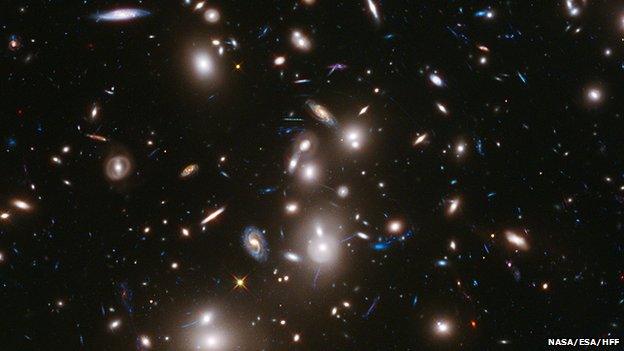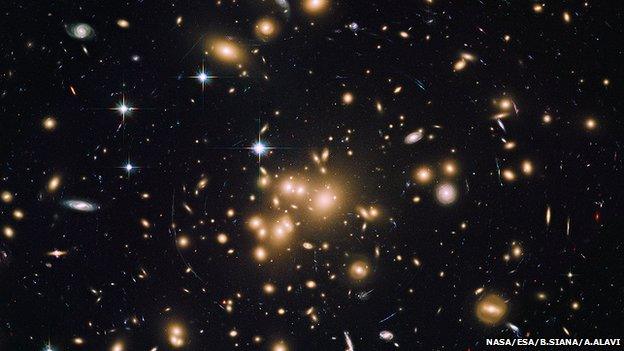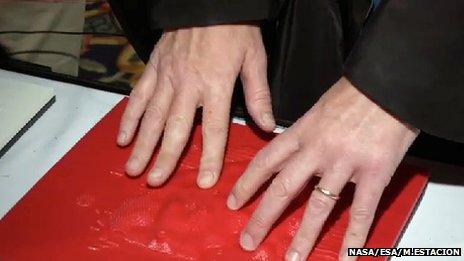Deepest galaxy cluster ever pictured by Hubble
- Published

The blue arcs are distant galaxies whose faint images are magnified by a massive cluster in the foreground
The "deepest ever" image of a group of galaxies - "Pandora's Cluster" - has been captured by the Hubble Space Telescope.
The blue arcs in the picture are distant galaxies as they appeared 12 billion years ago - not long after the Big Bang.
The hidden objects are revealed through the "magnifying lens" of the cluster Abell 2744.
The image was unveiled at the 223rd meeting of the American Astronomical Society, external (AAS) in Washington DC.
It is the first in a set of super-deep views of the Universe taken by Hubble's Frontier Fields observing programme, and published on the Arxiv preprint server, external.
Funhouse mirror
In the foreground are the colourful spirals and elliptical galaxies of Abell 2744, a massive cluster in the constellation Sculptor.
It is nicknamed Pandora for its strange and violent formation history, which unleashed many new phenomena to astronomers.

One of the earliest galaxies ever seen - as it appeared 13.2 billion years ago
Abell's immense gravity acts as a lens to warp, brighten and magnify more distant objects lurking in the background.
The long exposure by Hubble reveals almost 3,000 of these background galaxies, interwoven with hundreds in the foreground.
The faintest is 10-20 times fainter than any galaxy ever seen before.
They appear brighter thanks to the lensing phenomenon, but are also smeared, stretched and duplicated - like faces in a funhouse mirror.
The remarkable photograph will be combined with images from Nasa's Spitzer telescope and Chandra X-ray Observatory to give new insights into the origin of galaxies and their accompanying black holes.
It was one of three spectacular new findings by Hubble unveiled at the AAS conference.
Four brilliant young galaxies have been pictured as they were 13.2 billion years ago - just 500 million years after the Big Bang.
The brightest was forming stars 50 times faster than our Milky Way does today, but is only one twentieth the size.

These previously unseen galaxies gave birth to most stars in the cosmos today
Although Hubble has previously identified galaxies at this early epoch, astronomers were surprised to find objects 10 to 20 times more luminous than anything seen before.
"These just stuck out like a sore thumb because they are far brighter than we anticipated," said Garth Illingworth of the University of California at Santa Cruz.
"There are strange things happening... we're suddenly seeing luminous, massive galaxies quickly build up at such an early time. This was quite unexpected."
For the first time, the astronomers were able to estimate the masses of these early galaxies, by using Spitzer to measure their total luminosity.
"They were much larger than we expected to find. Only 1% of our Milky Way. But that is a big galaxy for that early era," said Dr Illingworth.
The discovery of such rich activity at the extreme limits of Hubble's range bodes well for Nasa's James Webb Space Telescope (JWST), currently in development.

3D printing brings Hubble's spectacular images to life for the visually impaired
JWST would allow astronomers to look even farther back in time to see some of the first galaxies ever made in the Universe.
"We're reaching back through 96% of the life of the Universe to these galaxies - that's an astonishing undertaking. And with James Webb, we can learn even more," said Dr Illingworth.
Another new striking image released from Hubble features the "unseen" galaxies thought to be responsible for the "baby boom" that created most stars we see today.
Deep exposures in ultraviolet light, made with Hubble's Wide Field Camera 3, revealed a sample of 58 small, faint galaxies that existed more than 10 billion years ago.
Normally too dim for Hubble to see, these galaxies were revealed through gravitational lensing focused on the massive cluster Abell 1689 in the constellation Ursa Major.
"There's always been a concern that we've only found the brightest of the distant galaxies - the tip of the iceberg," said Brian Siana of the University of California at Riverside.
"We believe most stars forming in the early Universe occur in galaxies we normally can't see at all. Now we have found those 'unseen' galaxies, and we're really confident we're seeing the rest of the iceberg."
A new project to bring these stunning images to life for the blind and visually impaired was unveiled at the AAS meeting: 3D printed galaxies - with different textures for dust clouds, nebulae and other celestial features.
"The visually impaired can now explore and appreciate the beauty of Hubble images through touch," said Carol Christian, of the Space Telescope Science Institute.
"Our ultimate goal - anyone who would like to hold a piece of the Universe in their hands can get the data from Hubble and print them in their school, library, or their home."
- Published7 January 2014
- Published11 January 2012
- Published9 September 2013